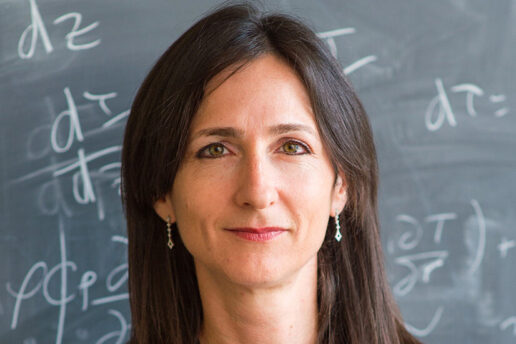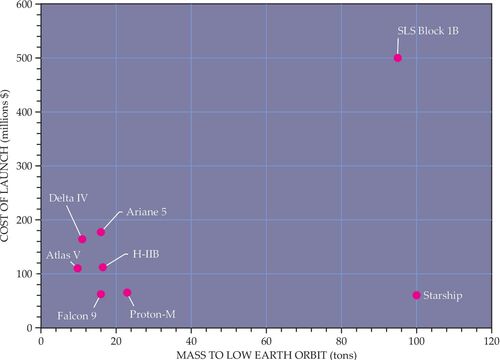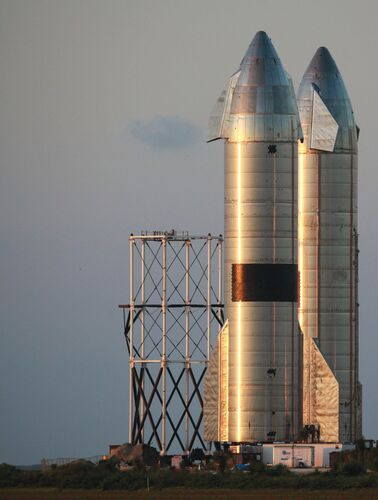
Accelerating astrophysics with the SpaceX Starship
By substantially increasing the mass and volume of its reusable transportation system without raising costs, SpaceX may enable NASA to implement future missions years ahead of schedule.
Martin Elvis is a senior astrophysicist at the Center for Astrophysics | Harvard & Smithsonian in Cambridge, Massachusetts. Charles Lawrence is the chief scientist for astronomy and physics at NASA’s Jet Propulsion Laboratory in La Cañada, California. Sara Seager is a physics professor at MIT in Cambridge.
Physics Today 76, 2, 40 (2023); https://doi.org/10.1063/PT.3.5176
From 2019 to 2021, the US astronomy community was engaged in a planning exercise for the coming decade and beyond. The result of that effort is the decadal survey Pathways to Discovery in Astronomy and Astrophysics for the 2020s. Commonly known as Astro2020, it envisages an ambitious set of new “Great Observatories” as the community’s top priority.1 (Each of the authors is closely associated with one of the observatories endorsed by Astro2020.) The new Great Observatories, some of which are shown in figure1, would collect measurements that span the electromagnetic spectrum, from far-IR to x rays, with orders-of-magnitude gain in capabilities over their renowned predecessors—the Spitzer Space Telescope, the Hubble Space Telescope, the Compton Gamma-Ray Observatory, and the Chandra X-Ray Observatory.

To keep within the NASA astrophysics budget, however, their launch dates have been pushed to the 2040s and 2050s, a forbidding timeline. A newly minted PhD today will be barely a decade from retirement by the time even the first of the observatories launches. The unwelcome implication is that there likely will be a decade-scale gap in flagship capabilities at all wavelengths in the 2030s to the detriment of science and of NASA’s technological leadership.
Astro2020 took place against a rather static background of space capabilities. Yet from late 2020, SpaceX has been developing an enormous and fully reusable launch system known as Starship, which consists of the Starship upper stage and the Super Heavy booster stage. The Super Heavy hasn’t flown yet, although Starship underwent dramatic progress, from early tests that resulted in multiple explosions—known tongue-in-cheek as “rapid unscheduled disassemblies”—to a successful high-altitude test flight and soft landing by mid 2021. Studies of the largest flagship missions that NASA commissioned took three years and were completed by 2019. The unfortunate timing meant that the capabilities of Starship could be only briefly considered in the Astro2020 deliberations.
Assuming it is successful, Starship will dramatically enhance our space capabilities in ways that will qualitatively alter how astrophysics missions can be built. The capabilities for planetary science missions in our solar system are discussed in the Origins, Worlds, and Life report, which emphasizes that Starship can accelerate the NASA planetary program.2 This paper discusses the parallel opportunities for astrophysics.
Mass, size, and cost
Astrophysics missions to space have always been tightly constrained by the capabilities of the launchers, which have not changed substantially in two decades. The three changes that Starship would bring are a much larger mass to orbit, much wider cargo bays, and no increase in—and potentially lowering—the cost per launch.
For decades the maximum mass brought to low Earth orbit has been around 10–25 metric tons (t). The Starship Users Guide says that the spacecraft will be capable of carrying about 100 t to low Earth orbit, which is 4–10 times more than other launchers (see figure 2). Starship will be able to put 21 t into geostationary transfer orbit and about 18 t into a Sun–Earth L2 Lagrange point orbit, a favored location for many classes of astrophysics missions, including the James Webb Space Telescope (JWST). Refueling in orbit is required for NASA’s lunar Starship Human Landing System.3 It could transport 100 t observatories to the Moon, to the L2 orbit, or almost anywhere in the solar system.2

Space observatories are deployed from the cargo bay of the upper stage, known as the payload fairing, of their respective launchers. They then fly independently for their operational lives, typically years to decades. All heavy-lift vehicles launched this century have had inner fairing diameters of 4–5 m. Starship will double that diameter to 8 m and marginally increase the typical payload height, as shown in figure 3.

Most launchers cost more than $100 million to design and build. Exceptions are the Proton-M and Falcon 9 vehicles, which cost about $60 million, but the production of Proton-M vehicles ended in 2022. The goal for Starship is to be cheaper than the Falcon 9 rocket.4 But even a launcher with zero costs would not be transformative without the large increases in payload mass and volume that Starship is designed to provide. A $60 million launch cost for NASA’s Medium-Class Explorer missions, for example, is 20% of the mission’s $300 million budget.
Revolution in mission design
Mass and volume have dominated space mission design, but Starship would reduce mass to a secondary design factor. That approach will simplify decisions and reduce the number of design cycles that must be completed before arriving at a workable solution. Spacecraft have traditionally demanded strict performance margins to save mass. But with looser mass requirements, mission designs can use simpler, heavier components and less exotic materials and incorporate more robust engineering margins. According to the Origins, Worlds, and Life report,
Starships can accommodate payloads that are significantly larger and heavier than traditional NASA planetary payloads, significantly reducing the need for the costly reductions in size and mass required for traditional NASA payloads. Starships can fly multiple payloads and instruments on individual flights to reduce overall risk, and significantly more power can be available for the payload. (reference 2, page 540)
During the design phase of NASA’s modest-sized Spectro-Photometer for the History of the Universe, Epoch of Reionization, and Ices Explorer (SPHEREx), for example, engineers used the mass available on the SpaceX Falcon 9 launch vehicle to help solve problems and contain costs. Allen Farrington, the project manager of SPHEREx at NASA’s Jet Propulsion Laboratory, told the three of us that “the approach that SPHEREx has taken from proposal through the critical design review is to convert risk to mass. A key example was the Sun–Earth shade, where we swapped out technically challenging, state-of-the-art, soft-goods-based technology for more massive but state-of-practice aluminum honeycomb panels. This resulted in a much lower risk posture and was enabled by the excess mass capabilities of our Falcon 9 launch vehicle.”
The JWST exemplifies the difficulties caused by tight size and mass constraints. The Ariane 5 launch vehicle constrained the total payload mass to 6.2 t. The JWST primary mirrors, including their support structure, are ⅙ of the total mission mass. That’s similar to the Hubble mirror but with nearly six times the area. A Hubble-style mirror for the JWST would have had a mass of almost 5 t, or ¾ of the total available payload.
The limitations of the launcher capabilities forced project scientists to develop novel, lightweight, high stiffness-to-mass technologies. Their choice of beryllium for the mirror material was driven in part by the need for high conductivity to minimize thermal gradients at the 20–55 K operating temperatures of the JWST.5 The need to deploy a large, thin sunshield had other consequences, including reducing slew rates and lengthening settling times, both of which have reduced the amount of scientific work that can be done each day.6
Even though the JWST successfully deployed, vindicating the technical approach, the complexity of the design required extensive planning and testing that added to the cost and lengthened the project’s schedule. With Starship’s large fairing diameter and volume, the 6.5 m JWST primary mirror could have been made of a single component with a mass per square meter similar to Hubble. At 5 t, the JWST would still have been only 10% of the mass deliverable to the Sun–Earth L2 orbit and, therefore, not a dominant design consideration. A single mirror avoids the complexity of aligning the 18 hexagonal mirror segments. Not all such origami deployments would be avoided by using Starship; the JWST sunshield is still larger than Starship’s proposed fairing size.
Although ambitious, reducing total mission cost by a factor of two is the crucial threshold for cost savings. The same budget can then fund twice as many missions, which would be transformative for the new Great Observatories program by potentially allowing for missions slated for the 2040s to happen in the 2030s. When a set of Great Observatories is operating contemporaneously, the pace of discoveries is accelerated because findings by one observatory often lead to new investigations by others.
Gains for all bands
Astronomy observations now are collected across more than 10 decades of frequency of the electromagnetic spectrum, from 108 Hz in the radio band to more than 1018 Hz in x rays. The ways in which missions could benefit from Starship’s capabilities depend on the band. The missions proposed in Astro2020 white papers can serve as a guide. Together the missions cover virtually every band of the electromagnetic spectrum along with alternative messengers such as cosmic rays and neutrinos.
For the traditional radio band at centimeter wavelengths, the obvious next step is extending very long baseline interferometry to longer baselines than Earth’s diameter. That will let researchers obtain higher angular resolution and faster and denser uv-plane coverage, which allows for concomitant high-dynamic-range imaging. The Russian Spektr-R and Japanese Haruka missions, with modest payloads of 1–2 t, demonstrated technical feasibility and the existence of radio sources for study.7 Both missions produced limited results because of their moderate dish sizes of 8–10 m and their single Earth-to-space baselines.
Starship could, in a single launch, deploy multiple antennae up to 30 m in diameter using a mechanism similar to the unfolding of an umbrella. The millimeter-wavelength tolerances of the antennae would allow for the detection of various celestial objects. The gain in uv-plane coverage from multiple antennae scales with the number of baselines NBASELINES, which increases rapidly with the number of antennae n: NBASELINES = n(n − 1)/2. Although launch costs are unimportant with Starship, simultaneously launching an entire array could shorten project construction times and save costs.
Radio astronomy at frequencies of less than 30 MHz and wavelengths greater than 10 m could give access to the “dark ages,” the time before the first stars formed, by using the cosmological signature from neutral hydrogen.8 That approach is infeasible from Earth because of ionospheric blocking and the high human-created radio background. The lunar far side may be the only site in our solar system from which that cosmological signal is detectable because the Moon provides 90 dB suppression of Earth-based interference.9 It is possible, though, that galactic synchrotron emission will prove to be an insurmountable source of noise. The Starship could deliver 100 t to any lunar location, so it would be able to transport a telescope, and a crew could, if necessary, reconfigure it before they deploy it.
Perhaps the most famous recent result at millimeter to submillimeter wavelengths is the 2019 image of the shadow of the supermassive black hole in the galaxy Messier 87; it came from the Event Horizon Telescope, which is based on very long baseline interferometry. The image made headlines around the world, as did the 2022 image of Sagittarius A* in the Milky Way. Theory predicts fine structure in the image, but that can’t be confirmed with the 10 000 km baselines and limited frequency coverage accessible on Earth.
Longer baselines are possible from high orbits, although multiple antennae will be needed to give adequate uv-plane coverage. The higher angular resolution could reveal the physics at work in accelerating jets to near light speed and could increase the number of black hole shadows resolved from two to at least dozens.10
Really long baselines of greater than 300 000 km, made possible with the use of satellites in geostationary orbit or telescopes on the Moon, would allow a clean separation of the effects of general relativity from those of the astrophysical, even with a single baseline.11 Optical laser-communication technology has now reached a point at which data can be transferred at a high rate from low Earth orbit, and it should be demonstrated soon on longer-baseline telescopes.
Dishes for submillimeter astronomy must be designed to tolerances of tens of microns, a constraint that makes deployed optics less appealing and increased mass more appealing. Starship could deploy a stack of several monolithic 6-m-class dishes to geostationary orbit in a single launch to help lower costs and accelerate the schedule. Another Starship could put a submillimeter telescope anywhere on the Moon.
For the far-IR region of the spectrum, the Origins Space Telescope is a flagship concept that has been studied by NASA. It was conceived as a 5.9-m-diameter primary mirror cooled to just 4.5 K to have low thermal background noise across the whole 25–588 micron band. Origins would have much more sensitivity and spectral resolution than its predecessor missions, the Herschel Space Observatory and Spitzer. Early designs for Origins had already planned on utilizing one of three conceptions: the larger-diameter fairings, then known as the Big Falcon rocket, from Starship; NASA’s Space Launch System (SLS); or Blue Origin’s planned New Glenn launcher.12
The Origins concept study did not exploit the mass capability of Starship and SLS. Origins has a mass of only 13 t, even if all the contingencies and reserves are included.12 Like all far-IR observatories, Origins requires an orbit similar to the Sun–Earth L2 point: Such an orbit is far enough away from Earth so that its heat doesn’t interfere with data collection. Even for a non-refueled Starship, Origins could carry four times as much mass. That decision could lead to cost-saving opportunities from, for example, simplifying the choice of material for the primary mirror.
To support near-IR, optical, and UV astronomy, NASA conceptualized the Habitable Exoplanet Observatory, or HabEx, and LUVOIR missions for the Astro2020 survey.13 Those considered projects span a wide range of possible mirror diameters, from 2.4 m to 15 m. The most demanding science goal of each concept mission is to directly image exo-Earths—the Earth-like planets in the habitable zones of the stars they orbit—and to then measure the spectrum of their atmospheres in a search for biosignatures or other signs of life. However, the stars are so much brighter than the exo-Earths orbiting them that a demanding contrast ratio of 10−10 is needed. To balance cost against the number of exo-Earths expected to be accessible, Astro2020 instead recommended an unnamed mission that would use a 6 m primary mirror, which is a compromise between HabEx and LUVOIR. The unnamed mission has an anticipated launch date of 2045, primarily because of its $11 billion cost estimate.
A 6 m primary mirror could be carried by Starship to orbit, and it could have Hubble-like mass per unit area, or even greater, without causing problems for the designers. The larger available mass that could be brought to space by Starship offers novel design possibilities for the new missions anticipated by Astro2020. Astronomers and engineers will need to explore various designs to determine whether such missions can be built at lower costs.
For x-ray observations, the Lynx x-ray flagship concept studied by NASA, in preparation for Astro2020, was conceived as being hundreds of times more capable of imaging and high-resolution spectroscopy than Chandra’s 1.2-m-diameter mirror.14 The x-ray mirror of Lynx is 3 m in diameter with a subarcsecond angular resolution and features grazing-incidence optics, which reflect x rays at shallow angles. The mirror assembly constitutes 25% of Lynx’s mass, taking up 2 t of the envisaged 7.7 t total. To keep the mirror mass from exceeding the pre-Starship available payload, the Lynx scientists opted for thin, 0.5 mm mirror segments for its grazing-incidence optics. Starship would allow an x-ray mirror made of thicker, 2 mm segments. Since stiffness varies with thickness cubed, the mirror segments would be 60 times as stiff.
Attaining the subarcsecond image quality at the heart of the Lynx mission would then be much more easily accomplished. A simpler fixturing and alignment system that could be more rapidly assembled would likely lead to cost savings. As on other missions, the freeing of the mass constraint may lead to a lower-cost payload and spacecraft. The resulting 8 t mirror assembly is readily accommodated by Starship.
Outside of the new Great Observatories, there is a host of novel ideas for more modest-scale instruments. The Probe of Extreme Multi-Messenger Astrophysics (POEMMA) mission,15 for example, would use a pair of 4 m Schmidt telescopes pointing down from orbit to image extensive air showers (EASs) in stereo using fluorescence and Cherenkov flashes. EASs are created by both ultra-high-energy cosmic rays and neutrinos in Earth’s atmosphere. POEMMA images such cosmic rays when it is nadir-pointing and neutrinos as upward-moving EASs when it is limb-pointing. The large atmospheric volume probed from orbit gives POEMMA a 10- to 100-fold performance gain over state-of-the-art telescopes.
The low cost of Starship would allow for the launch of two POEMMA telescopes separately, and the launch vehicle’s large volume would remove the need for deployment mechanisms. An improvement of up to a factor of three in the collecting area could be gained by using the wide Starship fairing to launch larger, 6–7 m telescopes, although the cost of manufacturing the necessary 6 m Schmidt corrector lenses may preclude that option.
POEMMA is just one of the many probe-class mission concepts submitted in white papers for Astro2020. The $1.5 billion cost for probes estimated by Astro2020 means that only one per decade is affordable for the NASA astrophysics budget. Starship may enable cheaper probes so that more, and more unconventional ones such as POEMMA, can be developed.
Cheaper, faster, but beware of better
The space-science community can accelerate the Astro2020 program by taking advantage of Starship’s potential for cost savings, but that approach will require discipline from all involved. “Faster, better, cheaper” was the mantra of Daniel Goldin, the NASA administrator from 1992 to 2001, and it led to, at best, mixed results.16
Starship seems poised to provide faster and cheaper launch vehicles. The teams proposing missions will always want to put all the available mass budget, however large, into bigger mirrors and more instruments. That line of thinking leads, in many cases, to large and complex designs that will follow the expensive scaling of cost with mass that the astronomy community is used to. Pushing for “better” could jeopardize the faster and cheaper goals, so the community will need to develop best practices to restrain scientists’ appetite.
Space agencies will need to monitor for and avoid mission creep, but doing so will not be easy. Industry and agency models that predict mission cost often scale cost with mass. Starship could usher in a new paradigm in which increased mass would decrease cost. But that won’t be an easy exercise. Because there is no track record showing whether an approach that uses mass and volume to cut costs will be successful, that approach translates initially into higher risk.

Courtesy of NURPHOTO SRL/ALAMY STOCK PHOTO
Starship caveats
Starship may not reach expectations. It may operate, but at a much higher cost and at a reduced mass capability, or on-orbit refueling may not be achieved. The Starship launch costs given by SpaceX are presumably estimates of the cost to SpaceX, not the price to a customer, which will be more expensive. Perhaps most importantly, realizing dramatically lower launch costs depends on rapid and frequent reuse of each Starship, but a market for sufficient launches may not be forthcoming. The anticipated savings promised by Starship also may prove illusory after careful inspection.
Similar risks, however, apply to almost any new technological development. They are thus insufficient reasons to not consider what might have the biggest effect on astrophysics if the Starship technology is a success.
The NASA-developed SLS has comparable capabilities to Starship in terms of mass to low Earth orbit and payload volume. As such, it provides some backup for Starship. The $800 million to $2.7 billion cost estimate of an SLS launch, however, would be a major factor in any mission of even a $5 billion Great Observatory.17 Launch costs of that magnitude may put such an astrophysics mission out of contention, unless politically mandated. The SLS is fully expendable, so the rate of production of more launchers is a critical consideration. The production rate for Boeing, the lead contractor for the SLS, is limited to at most two SLS launchers per year.18 NASA’s Artemis human spaceflight program is expected to take most of the SLS launch slots over the next several years.17 Could three launches over the next decade or so be available for the new Great Observatories?
Even if Starship works as advertised, extra mass is not without disadvantages. More mass increases the moment of inertia of the spacecraft and so requires more massive reaction wheels to point to a target. In addition, station keeping in the popular Sun–Earth L2 halo orbits either will require proportionately more propellant or will limit mission lifetimes because of the extra mass.
Starship will likely be proven or not within the next five years. That gives NASA time to prepare for a new era of launch capability by the Astro2020 midterm review. A series of coordinated studies over the next few years to investigate in detail how Starship might accomplish, accelerate, and expand the Astro2020 program would prepare NASA’s astrophysics program to act if Starship succeeds. But even if Starship fails, the effort that is lost by planning for its success is small when compared with the potential gains to astronomy.
The authors thank Lee Armus, Jack Burns, Allen Farrington, Tom Megeath, Joe Silk, and Alexey Vikhlinin for valuable conversations. The cost information contained in this article is of a budgetary and planning nature and is intended for informational purposes only. It does not constitute a commitment on the part of the Jet Propulsion Laboratory and Caltech.
References
1. National Academies of Sciences, Engineering, and Medicine, Pathways to Discovery in Astronomy and Astrophysics for the 2020s, National Academies Press (2021). Google Scholar
2. National Academies of Sciences, Engineering, and Medicine, Origins, Worlds, and Life: A Decadal Strategy for Planetary Science and Astrobiology 2023–2032, National Academies Press (2022). Google Scholar
3. T. Burghardt, “After NASA taps SpaceX’s Starship for first Artemis landings, agency looks to on-ramp future vehicles,” NASASpaceflight.com, 20 April 2021. Google Scholar
4. A. Mann, “SpaceX now dominates rocket flight, bringing big benefits—and risks—to NASA,” Science, 20 May 2020. https://doi.org/10.1126/science.abc9093, Google Scholar, Crossref
5. H. Warren, “The mirror of the James Webb Space Telescope: Looking into the past,” NASASpaceflight.com, 13 November 2021. Google Scholar
6. K. Q. Ha, M. D. Femiano, G. E. Mosier, in Proceedings of SPIE, Volume 5528: Space Systems Engineering and Optical Alignment Mechanisms 5528, 126 (2004), doi: https://doi.org/10.1117/12.558456. Google Scholar, Crossref
7. Y. Y. Kovalev et al., in XXXIth URSI General Assembly and Scientific Symposium, 1 (2014), doi: https://doi.org/10.1109/URSIGASS.2014.6929994; Google Scholar, Crossref
H. Hirabayashi et al., AIP Conf. Proc. 599, 646 (2001). https://doi.org/10.1063/1.1434707, Google Scholar, Crossref
8. J. D. Bowman et al., Nature 555, 67 (2018); https://doi.org/10.1038/nature25792, Google Scholar, Crossref
J. Silk, Found. Phys. 48, 1305 (2018). https://doi.org/10.1007/s10701-018-0183-y, Google Scholar, Crossref
9. J. O. Burns et al., Planet. Sci. J. 2, 44 (2021). https://doi.org/10.3847/PSJ/abdfc3, Google Scholar, Crossref
10. D. W. Pesce et al., Astrophys. J. 923, 260 (2021). https://doi.org/10.3847/1538-4357/ac2eb5, Google Scholar, Crossref
11. M. D. Johnson et al., Sci. Adv. 6, eaaz1310 (2020). https://doi.org/10.1126/sciadv.aaz1310, Google Scholar, Crossref
12. M. Meixner et al., https://arxiv.org/abs/1912.06213. Google Scholar
13. S. Gaudi et al., Bull. Am. Astron. Soc. 51(7) (2019), paper no. 89; Google Scholar
LUVOIR team, https://arxiv.org/abs/1912.06219. Google Scholar
14. A. Vikhlinin, Bull. Am. Astron. Soc. 51(7) (2019), paper no. 30. Google Scholar
15. A. V. Olinto et al., Bull. Am. Astron. Soc. 51(7) (2019), paper no. 99. Google Scholar
16. H. E. McCurdy, Faster, Better, Cheaper: Low-Cost Innovation in the U.S. Space Program, Johns Hopkins U. Press (2001). Google Scholar
17. E. Berger, “Finally, we know production costs for SLS and Orion, and they’re wild,” Ars Technica, 1 March 2022. Google Scholar
18. J. Foust, “NASA and Boeing look ahead to long-term SLS production,” SpaceNews, 11 December 2019. Google Scholar
© 2023 American Institute of Physics.


